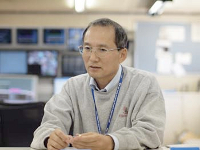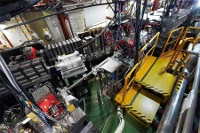 |
 |
|||||||||||||
|
|||||||||||||
|
|||||||||||||
|
In late October, the fast kickers at the Accelerator Test Facility (ATF) at KEK have successfully kicked the beam bunches in 5.6 nanoseconds. Conditioning these bunches is the job of the damping rings, and the kicker system is one of the crucial technologies which hold the key of the damping ring performance.
ILC linacs will use superconducting radiofrequency cavities to accelerate a long bunch train, comprising over 2800 bunches spaced at 330 nanoseconds. Such bunch trains will easily exceed 200 kilometres in length, and would be impossible to store into the damping ring as a whole. So, the bunch-to-bunch spacing have to be compressed to a distance of three (or six) nanoseconds into the damping ring, and it has to be decompressed back to 330 nanoseconds when kicking out from the damping ring – this is the reason why the kicker needs to be very fast. The kicker has to rise quickly to kick the targeted bunch only, and to fall quickly not to influence the next bunch coming in just three or six nanoseconds. “It was impossible to realise these challenging requirements by conventional kicker systems, such as ferrite-pulsed magnets powered by a thyratron switching power supply. That's we developed the strip-line kicker system,” said Takashi Naito, an engineer at the accelerator laboratory at KEK. The strip-line kicker system consists of multiple units of strip-line electrodes and a very fast-pulsed power supply using semiconductor switches. “We knew that the strip-line scheme works well in 2007 from the accumulated data with which I wrote my paper. But to demonstrate that was another thing,” said Naito. One of the key technologies is high voltage to drive the strip-line. The strip-line has been used for accelerators before. For example, the KEKB accelerator used them for a bunch-by-bunch feedback system to suppress the beam oscillations. “But it only needs small kicking angles. For beam extraction, the kicking angle will be much larger, and that requires high voltage,” said Naito. The conventional thyratron works well to make larger kicking angles with its 40 kilovolts. However, it is very difficult to achieve high-speed switching, high voltage and a high frequency all at once with an ordinary switching device such as thyratron. “We used a semiconductor high-voltage pulse source and confirmed its performance, however, the kicking angle was inadequate.” Two units of strip-lines produced about three milli-radian of the kicking angle. ATF requires five milli-radian. Installing more strip-lines could have helped to solve this problem, but another hurdle to clear was ATF itself. “There was not enough space to install additional strip-lines to produce the required kicking angle.” The team had to manage to fit the system into existing ATF, already busy with equipments and cables. “To realise the beam extraction, we used local bump magnets and an auxiliary septum magnet to make the beam extraction trajectory,” said Naito. “We have confirmed this system worked. But we still have more work to do. We should have been able to extract up to 30 bunches, but could extract 17 bunches, which was due to an injector problem at that time. Also we need to seek more stability in the timing jitter.” The next test is scheduled for March 2010. -- Rika Takahashi |
|||||||||||||
| © International Linear Collider |

